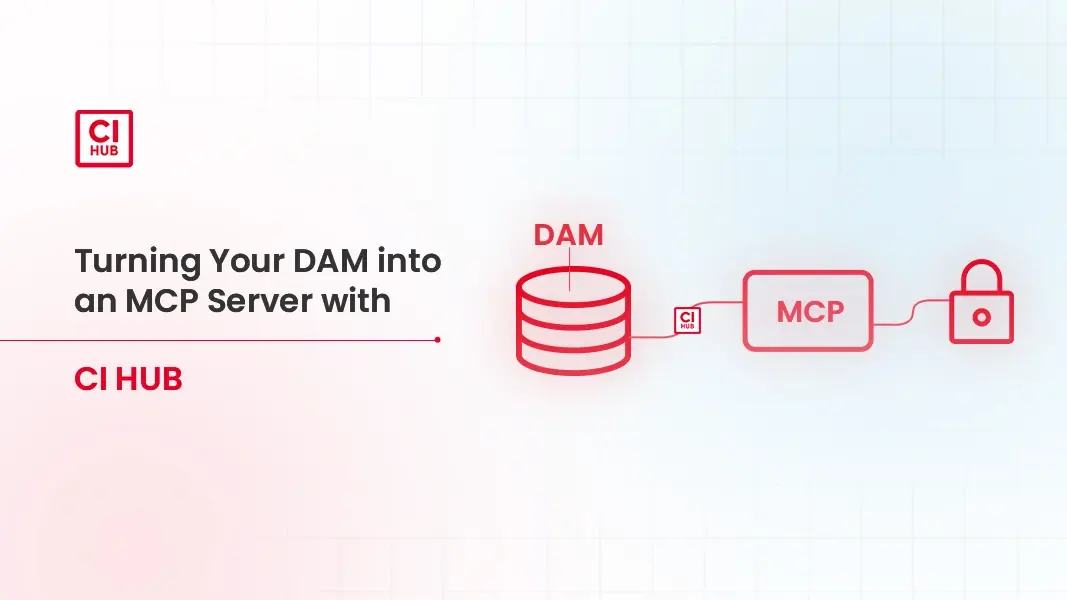Your DAM, Powered by AI
Connect your assets to AI safely and unlock smarter workflows across your organization.

September 28, 2025
Generative AI and large language models (LLMs) are transforming how companies around the world are working. They can generate content, create designs, analyze trends, and support teams with instant answers, to name only a few of their uses.
But they do not know your company’s data. If you ask an AI tool to write a product launch email using the latest images from your Digital Asset Management (DAM) system, it would not find them. This is because AI models are trained on public data, not your private corporate content.
This is where an MCP (Model Context Protocol) server plays a vital role by acting as the secure link between your private data and public AI tools. It gives AI access to approved content while keeping control in your hands. Let’s understand how this connection transforms the role of AI in enterprise DAM.
Digital Asset Management (DAM) platform is already a central part of your content ecosystem. It stores and organizes brand images, videos, design files, documents, and product data. It ensures that only approved content is available to teams.

However, in the new era of AI, a standalone DAM creates several challenges:
In short, your DAM becomes a “walled garden,” a secure and rich library, but invisible to AI models and disconnected from the creative tools your teams use every day.
If this gap stays, AI will never be able to fully support your business processes.
Instead of letting your DAM only serve as storage, you can turn it into a live, intelligent data source for AI models.
This happens when your DAM becomes an MCP server. An MCP server uses a common protocol to allow AI tools to safely ask for and retrieve data from your DAM in real time. This approach is the core of digital asset management integration in the AI age.
With this setup:
Simple analogy:
This is one of the major MCP server benefits for modern businesses.
Connect your assets to AI safely and unlock smarter workflows across your organization.
This transformation might sound complex, but the CI HUB Connector makes it fast and practical. Instead of building custom integrations or replacing your DAM, CI HUB lets you add MCP capabilities on top of your existing systems.
Here’s how it works:
CI HUB connects with leading DAM and content systems like Adobe Experience Manager, Bynder, Sitecore Content Hub, Dropbox, Google Drive, and more. You can activate the MCP server using a simple connector. No major coding or infrastructure changes are needed.
Security is a top concern when exposing data to AI. CI HUB allows you to define exactly which assets are available, to whom, and in what context.
You can:
This keeps your corporate data safe while still enabling innovation. It delivers secure DAM integration without adding complexity to your workflows.
Traditional workflows involve exporting files and hoping they are up to date. With MCP integration, AI tools pull the latest version directly from your DAM whenever needed.
This ensures:
Your DAM becomes a single source of truth that always delivers current, approved assets to AI-powered workflows. This reliable AI asset access is what makes MCP so powerful.
When your DAM becomes an MCP server, it does more than just connect to AI. It opens new ways for teams to work faster, smarter, and more accurately.

Here are a few real-world examples of what this enables:
This creates a future where AI works side by side with your teams using the same trusted content they do. It transforms your DAM into an active, AI-ready engine, rather than a passive storage space.
AI is reshaping how teams create and use content, but it can only deliver real value when it works with your company’s own data. Turning your DAM into an MCP server with the help of CI HUB closes this gap. It allows AI to securely access up-to-date, approved assets while you stay in full control of what gets shared and how it’s used.
Instead of being just a storage system, your DAM becomes an active, AI-ready DAM that powers faster workflows, smarter collaboration, and consistent brand experiences across your organization.
Contact us today to learn more and be among the first to join the journey toward AI-ready asset management.
An MCP (Model Context Protocol) server acts as a secure bridge between your DAM and AI tools. It allows AI models to safely request and use approved assets stored in your DAM without exposing all your data.
It provides a one-click connector that links your DAM with AI tools using the MCP protocol. This lets AI models access only the content you approve, while you stay in control of permissions and security.
Yes. With MCP server technology, you can control which users, teams, or AI tools can access specific assets. All content stays within your secure environment and follows your company’s data governance rules.
It transforms your DAM from a static storage system into a live data source. This enables real-time AI-driven workflows, reduces manual asset searches, and ensures that only the latest approved assets are used.

Article by
Michael Wilkinson
Marketing & Communications Consultant of CI HUB